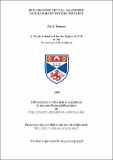Files in this item
Femtosecond optical parametric oscillators in the mid-infrared
Item metadata
| dc.contributor.advisor | Sibbett, Wilson | |
| dc.contributor.author | Penman, Zoe E. | |
| dc.coverage.spatial | 170 p. | en_US |
| dc.date.accessioned | 2018-07-05T08:16:27Z | |
| dc.date.available | 2018-07-05T08:16:27Z | |
| dc.date.issued | 1999-04 | |
| dc.identifier.uri | https://hdl.handle.net/10023/14947 | |
| dc.description.abstract | The work described in this thesis is concerned with the development of self-modelocked Ti:sapphire lasers and femtosecond optical parametric oscillators based on periodically-poled rubidium titanyl arsenate and periodically-poled lithium niobate and operating in the near and mid-infrared. In Chapter 1 the theory of ultrashort pulse generation is explained with regard to the Ti:sapphire laser. The optical properties of Ti:sapphire are discussed along with the principles of laser oscillation and pulse generation. The techniques used to modelock the lasers used in the experimental work, which follows, are also considered. The second part of the chapter deals with typical measurement techniques for characterising femtosecond optical pulses from a laser or an OPO, including a detailed explanation of second harmonic generation autocorrelation. Chapter 1 concludes with a thorough description of frequency-resolved optical gating, the newest of these pulse characterisation techniques. In Chapter 2 the subject of nonlinear optics and the properties of nonlinear optical materials are discussed. Phasematching in nonlinear optical materials is explained along with the principle techniques for achieving this, including birefringent phasematching and quasi-phasematching. A review of techniques for periodically- poling nonlinear optical crystals is also given. The chapter concludes with a section on the optical effects of group velocity dispersion and self-phase modulation, that influence the output from an ultrashort pulse laser or OPO and describes methods for second and third-order dispersion compensation. Chapter 2 concludes the theory required to explain the experiments described in Chapters 3, 4, 5 and 6. Chapter 3 describes the operation and characterisation of two different Ti:sapphire laser systems involving different methods of dispersion compensation. The first laser produces 100 fs duration self-modelocked laser pulses and dispersion compensation is achieved by including a pair of prisms in the cavity. This laser system is discussed further in Chapter 5, where it is operated in conjunction with a Spectra Physics Millennia, as the pump source for an all-solid-state femtosecond OPO based on periodically-poled lithium niobate. A second laser system is described in Chapter 3, which produces self-modelocked pulses of ~15 fs duration and dispersion compensation is achieved by including chirped multilayer dielectric mirrors in the cavity. The subject matter that Chapter 4 is concerned with includes the operation and characterisation of a femtosecond OPO based on PPRTA. Ti:sapphire pump wavelength tuning and cavity-length tuning of the OPO are shown to produce wavelengths throughout the range 1.060 mum to 1.225 mum in the signal and 2.67 jam to 4.5 mum in the idler, with average output powers as high as 120 mW in the signal and 105 mW in the idler output. The effects of photorefractive damage are minimal and consequently this offers the possibility of room-temperature operation of the PPRTA- based OPO. Chapter 5 is concerned with the generation of longer idler wavelengths, in the region of 5 mum, from an all-solid-state OPO based on periodically-poled lithium niobate. The approach used with the PPRTA-based OPO is extended to PPLN and in Chapter 5, results are presented which show that the use of an all-solid-state Ti:sapphire pump source in combination with a PPLN-based OPO represents a robust source of high- repetition-rate femtosecond pulses in the mid-infrared at wavelengths out to ~5 mum. Significantly higher output powers in the signal and idler than previously reported are also measured. In Chapter 6 a similar PPLN-based OPO is described, with modifications to the cavity elements, to reduce the output pulse duration of the OPO. This system is pumped by a sub- 20 fs Ti:sapphire laser. A pulse duration of 175 fs is recorded for the signal at a wavelength of 1.07 mum. Output powers of 28 mW for the signal at 1.07 mum and 6.8 mW for the idler at 2.7 mum are also measured. The tuning range for the signal extends from 1.045 mum to 1.190 mum, and for the idler, extends from 2.57 mum to 3.67 mum. | en_US |
| dc.language.iso | en | en_US |
| dc.publisher | University of St Andrews | |
| dc.subject.lcc | TK7872.O7P4 | |
| dc.subject.lcsh | Oscillators | |
| dc.subject.lcsh | Optical parametric oscillators | |
| dc.title | Femtosecond optical parametric oscillators in the mid-infrared | en_US |
| dc.type | Thesis | en_US |
| dc.contributor.sponsor | SERC | en_US |
| dc.type.qualificationlevel | Doctoral | en_US |
| dc.type.qualificationname | PhD Doctor of Philosophy | en_US |
| dc.publisher.institution | The University of St Andrews | en_US |
This item appears in the following Collection(s)
Items in the St Andrews Research Repository are protected by copyright, with all rights reserved, unless otherwise indicated.

